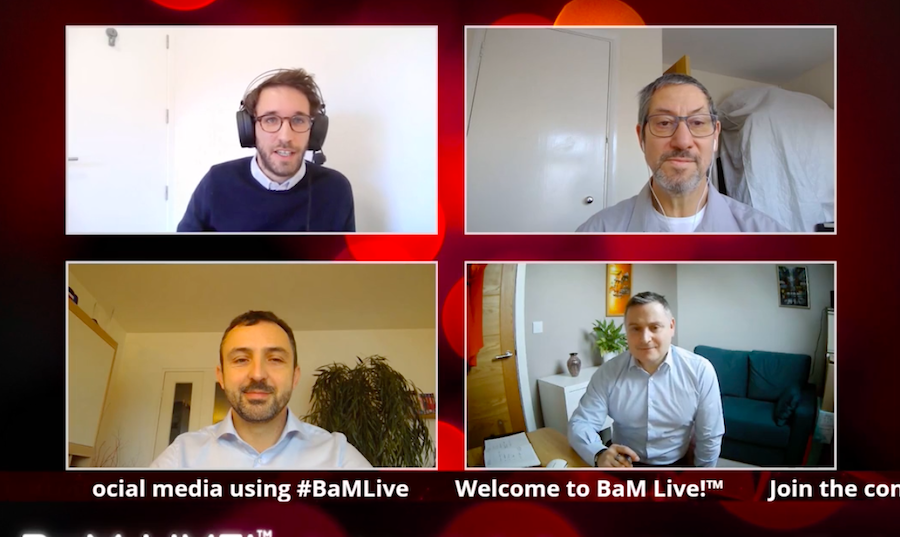
Waking up last week, it hadn’t escaped my attention that I was due to open my bedroom curtains to the sights of Amsterdam city center. Instead, as we all know, IBC 2021 had to switch plans and revert to a digital format quickly. And so too did Thursday’s ‘IABM BaM Live!’ session, where I spent a very enjoyable half an hour in the company of Lorenzo Zanni (IABM), Micky Edwards (TAG), and Remi Beaudouin (Ateme), discussing all things cloud and SaaS. You can now watch this session here, on-demand.
SaaS business models are an exciting prospect for the media industry. They provide many clear benefits, but they have also forced us to think very differently. Traditionally, we came from a hardware-centric world that revolved around supplying various boxes. The business model was straightforward – it was CAPEX-driven, with equipment replaced by next-step technology every few years.
For a while, most people in our industry assumed that we were going to leap from on-premise to cloud and that within a matter of a few years, we would be deploying new infrastructures and architectures that would align accordingly. That’s not been the case, with many in the media industry opting to support what they already have, relying on incremental upgrades. The challenge now is to create a more fluid ecosystem where customers and partners work together collaboratively. It’s not going to happen overnight, partly because the hybrid world we exist in needs to support itself.
Consumer habits vs. technology revenues
We have transformed the MediaKind business model to become much more consumer and solution-centric. It enables our customers to have a huge amount of flexibility. We can help them add channels instantaneously, spinning them up and down, adapting to peak flows, and charging accordingly, with disaster recovery running on a completely different pricing model. This new level of flexibility means that we can start to help our customers with their profit and loss margins and help them recognize the revenue opportunities available to them.
There are very close ties between leveraging technology to create new business models and the types of ‘live without limits’ streaming offerings that we can make for the consumer. The flexibility that the cloud and SaaS bring means that we can enter areas such as targeted advertising to leverage the data available in the ecosystem and across the entire AV pipe in the cloud.
This means we can create more compelling offerings for consumers and work alongside our partners to improve our offering continually, whether it’s the video quality, stability, or even the sustainability within the AV pipes themselves. For instance, we can now leverage AI to manage the number of resources used. All these areas are now opportunities moving forward. If we want to enter a more fluid and consumer-centric universe, our industry needs to embrace the transition towards cloud ecosystems and SaaS financial models.
MediaKind and Arqiva launch partnership to break down barriers to cloud migration
Over the last few years, MediaKind has started to look at what ‘best-of-breed technology really means. Of course, there’s best-of-breed video quality and performance, and the same can be said of best-of-breed architecture. However, we see the importance of partnerships as a fundamental element in tackling the core migration challenges broadcasters and operators face today.
As a result, we’ve dedicated a lot of time to focusing on ways we can interoperate with our customers and partners. One such example is BCNEXXT-VIPE; they’re one of the very best in cloud playout. By working within their ecosystem, we are evolving in tandem with the current requirements of the broadcast industry. More specifically, these relationships mean we can provide best-of-breed solutions rather than single best-of-breed components. As an industry, we will all need to combine with partners and cloud providers and learn from one another. This will ensure that we can operate in equivalent environments.
And that’s why we’re so proud to announce our new partnership with Arqiva. Never have two media broadcast and streaming heavyweights worked so collaboratively to change the nature of managed video services. Our joint service offering means we can deliver a unique cloud-native, fully managed service for the aggregation, processing, and delivery of television services for any platform (broadcast and OTT) in any region and at any scale. We embrace that Arqiva was once our customer – as they do us as a former vendor. Together, we can combine Arqiva’s market-leading position as a global managed media service provider, with our own global outlook as a powerful, innovative provider of media technology solutions.
We’re also collaborating closely with cloud vendors and our customers to make their journey to the cloud as frictionless and efficient as possible, creating ‘managed cloud applications’ (MCAs) that support both software-as-a-service (SaaS) models and the customers’ own cloud choice. This means they retain control of the cloud infrastructure and migration process while MediaKind handles the monitoring, performance, and software updates. You can learn more about MCAs in our latest application paper, ‘Media in the Cloud: The evolution of operational models.’
An early forecast for 2022!
At the end of the session, I was asked to project into next year a little. First and foremost, I hope we’re moving closer towards the latter stages of the pandemic. At the very least, we’re certainly becoming more accustomed to the challenges it brings, and we are starting to get closer to our customers once more. We had a great piece in FEED magazine earlier this week which discusses a lot of the great activities around the MediaKind Roadshow, where we’ve taken our demonstrations right to our customers and partners’ doorsteps. Likewise, we recently hosted a brilliant customer event in London, which my colleague David Symons captures in this blog. Overall, we’ve maintained a closeness with our customers – but there’s nothing like meeting face-to-face, and I look forward to doing just that when it is deemed safe to do so in 2022.
If you want to learn more about my broader predictions for the industry next year – stay tuned for my next blog post later this month!


